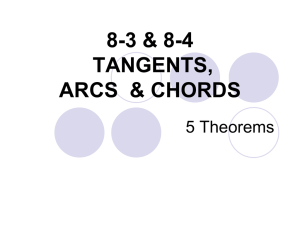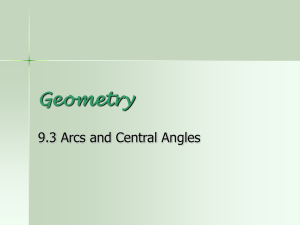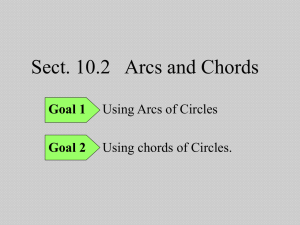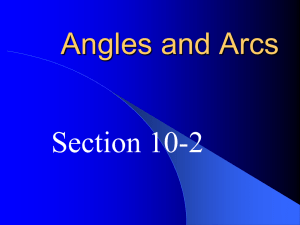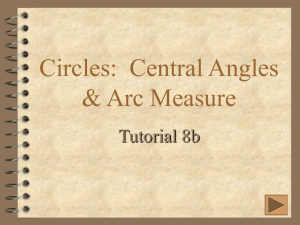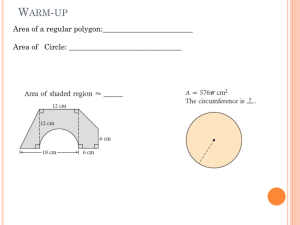Sect_ 10_2 Arcs and Chords
advertisement
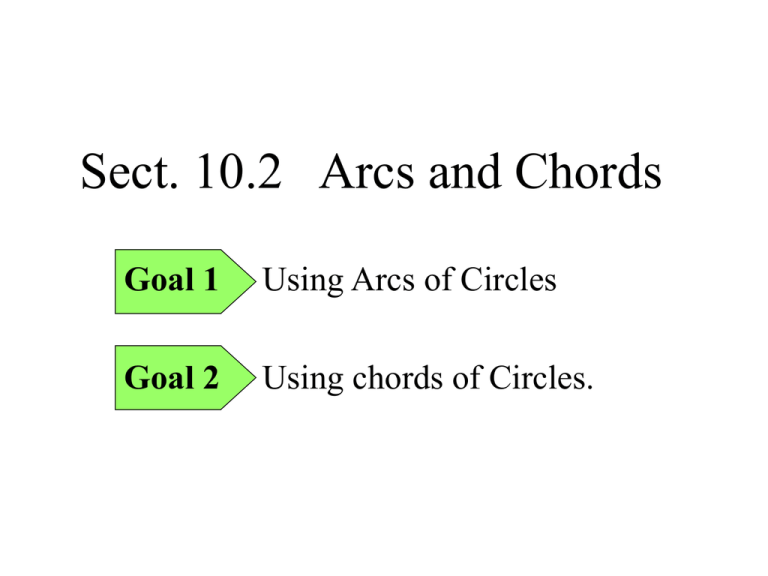
Sect. 10.2 Arcs and Chords Goal 1 Using Arcs of Circles Goal 2 Using chords of Circles. Using Arcs of Circles The Central Angle of a Circle – A CENTRAL ANGLE is an angle whose vertex is at the center of a circle. Sum of Central Angles - The sum of the measures of the central angles of a circle with no interior points in common is 360°. Using Arcs of Circles Every central angle cuts the circle into two arcs. The smaller arc is called the Minor Arc. The MINOR ARC is always less than 180°. It is named by only two letters with an arc over them as in our example, . The Minor Arc The larger arc is called the Major Arc. The MAJOR ARC is always more than 180°. It is named by three letters with an arc over them as in our example, . The Major Arc Using Arcs of Circles The Semicircle (Major Arc = Minor Arc) : The measure of the semicircle is 180°. SEMICIRCLES are congruent arcs formed when the diameter of a circle separates the circles into two arcs. Using Arcs of Circles Definition of Arc Measure • The measure of a minor arc is the measure of its central angle. Central Angle = Minor Arc The measure of a major arc is 360° minus the measure of its central angle. Using Arcs of Circles Example 1: Find the measure of each arc. 1. 2. X A 148° G XB GXB 3. GBX B Using Arcs of Circles Postulate 26 Arc Addition Postulate The measures of an arc formed by two adjacent arcs is the sum of the measures of the two arcs. That is, if B is a point on , then + = . Using Arcs of Circles Example 2: Find the measure of each arc J K 60° 82° 1. JKB 100° 2. BGJ 3. JG A G B Using Arcs of Circles Example 3: Find the measures of KJ and GB . Are the arcs congruent? Why? J K 60° A 60° G B Using Chords of Circles If two arcs of one circle have the same measure, then they are congruent arcs. Congruent arcs also have the same length. Using Chords of Circles When a minor arc and a chord share the same endpoints, we call the arc the ARC OF THE CHORD. Using Chords of Circles Theorems about Chords Theorem 10.4 In a circle or in congruent circles, two minor arcs are congruent if and only if their corresponding chords are congruent. EF AB Using Chords of Circles Example 4: Find the measure of G GJ (2x+48)° (3x+11)° A J K B Using Chords of Circles Theorem 10.5 In a circle, if a diameter is perpendicular to a chord, then it bisects the chord and its arc. (Hint): This diagram creates right triangles if you add radius OA or OB. AC BC AN BN Using Chords of Circles Example 5: In the diagram, FK = 40, AC = 40, AE = 25. Find EG, GH, and EF. K H G F E A D B C Using Chords of Circles Theorem 10.6 If one chord is a perpendicular bisector of another chord, then the first chord is a diameter F A FB is a diameterof circle E E D B C Using Chords of Circles Theorem 10.7 In a circle or congruent circles, two chords are congruent if and only if they are equidistant from the center. Chords are congruent if they are equidistant from the center, they are also congruent if there arcs are the same size. Using Chords of Circles Example 7: Find the length of the radius of a circle if a chord is 10” long and 12” from the center. Using Chords of Circles Example 8: C Find the measure of: BC , DC, and BDC D (3x + 11)° A (2x + 48)° B Using Chords of Circles Example 9: Locate the center of the following C circle. D B J Homework Worksheet provided
